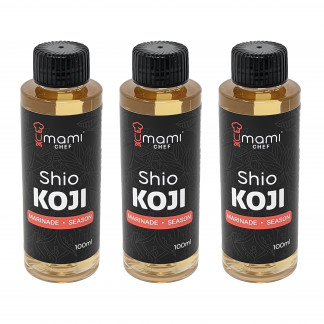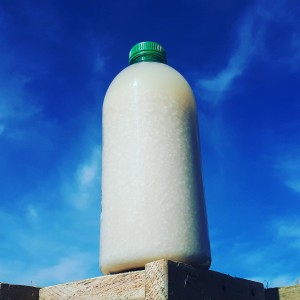
Mirin
Mirin is a sweet wine used in Japanese cookery. In the UK we’re most familiar with its use in teriyaki sauce, but it is used in a wide range of other Japanese dishes.
Traditionally mirin is made from shochu, a Japanese spirit usually made from sweet potato. Shochu is difficult (and expensive) to get hold of in the UK, so I’ve used vodka.
It’s really easy to make – just mix koji, cooked rice, and a neutral tasting spirit. Then leave at room temperature for 2 – 3 months. I mixed 300ml vodka, 100g koji and 100g of cooled, cooked rice.
After 3 months the mirin develops a rich golden colour. At this stage you can strain off the solids or leave it to mature further. I like to leave the solids in the liquid, carefully pouring off the amount I’d like to use for each recipe. This means I get the best of both worlds – the ability to use it now and for it to mature further with time.
Much of the mirin available in the UK is made from sweetners and not produced in the traditional way. By creating your own mirin you get to experience a product that is naturally fermented and rich in nutrients.
Vodka Mirin
Ingredients
- 300 ml vodka
- 100 g koji
- 100 g cooked rice cooled
Instructions
- Mix the ingredients in a clean bottle
- Leave to mature for 3 months
- Strain off the solids and enjoy the mirin in teriyaki or your favourite Japanese dish


















Do you cover the bottle while it ferments?
Yes, I just put a normal stopper in the bottle. No gas is created during mirin production
Is the koji dry or wet?
I used dry, but you can use either
Do you grind or blend the rice and Koji rice at all?
No, I just keep it whole. It will still work if you blend the rice, but just make it more difficult to filter out at the end.
Isn’t koji rice? So you are just using 2 types of rice? What type of cooked rice?
Koji rice is a special rice which has the fungi aspergillus oryzae growing through it. This fungi has eaten all the rice that was present and so koji rice is almost all aspergillus oryzae. The mirin recipe calls for koji rice and normal rice (any will do – sushi rice, basmati rice, jasmine rice etc) so the enzymes in the koji can work on the carbohydrates in the rice.
can you use sake (shochikubai) instead of vodka or shochu?
can you use sake and shochu? I did not have enough vodka.
Hi Mimi, You can use any alcohol with a high enough alcohol content – roughly 20% or more. Sake normally has an alcohol content below 15%, so I wouldn’t advise using it. Any spirit should be OK.
This recipe is about 95% better than any other recipe I found (initially).
It is more than: use sake and sweeten it.
However I have got one issue: mirin is not a fermented product. The fact, that no gas is produced is basically telling you, that there is no microbial action going on. It is an enzymatic conversion (enzymes… fermentation is based on yeast and bacteria).
Just saying…
Hi Dominik, It’s great to hear that you’ve found the recipe useful!
There are many different definitions of fermentation, it really depends on which branch of science you’re following. Most fermented food definitions include enzymatic conversion as a form of fermentation, but I’m happy for you follow your own naming conventions. Either way it’s a delicious result!
It´s nice to see recipes for mirin popping around. 🙂 I´m going to make my own as well – plan to grow koji this weekend and then mix it with sticky rice and vodka.
I just have one question on my mind.
The enzymes in koji work even in full strenght vodka (approx. 40% alc.)? Alcohol this strong doesn´t hinder enzymatic activity? Traditional shochu is about 25%, so I wonder.
Regards
That is a good question! I’m afraid I don’t know the answer to that. All I do know is that I have successfully made mirin using vodka several times. It might slow down activity (it might not?), but those enzymes are still working.
I´m try to find out – wrote to Japan to several mirin makers. 🙂
I asked about enzymes acitivity in strong alcohol, like awamori for example.
First reply was straight – we never used anything else than shochu so we do not know.
🙂
I have seen recently people making mirin with slightly diluted everclear (to 80%) and it seems to have worked for them. I was also really curious how it was able to work at such a high alc percentage.
Hi,
I have shio koji in the fridge. Would I be able to use that in place of the rice koji? Would the salt in the shio koji affect the making of the mirin?
Hi Bonnie, No, sorry, the salt from the shio koji will mean that the mirin doesn’t taste right. Use koji rice for mirin.
Is the 100 grams of rice weighed pre or post cooking?
It is post cooking – 100g of cooked rice
Read the article: 100g of cooked, cooled rice.
BTW. Mine is coming on lovely.
5 months now, golden brown,
#finer temptress#
Cheers, mate 07
Great news! Get another batch started, as when it reaches 12 months old it will be so delicious you’ll wish you had double!!!
Bottled it today, after the laborious stages of super-fine cheesecloth, coffee filter papers.
And it is still cloudy!
I am not bothered, as the taste is sublime.
I wonder if the professionals use finings to clear the juice?
My effort is less sweet than Hinode Hon Mirin, which I have, but much, much more flavourful.
Got the next batch on the go as we speak.
Thank you for your recipe, and guidance, I trawled t’internet, and yours is the best.
Laters, Rob.
じゃあね
Hi Rob, Great to hear that it’s delicious. I imagine that the professionals use fine filters to remove all the visible particles. Thank you for the lovely comments!
Bonjour, je viens de couler mon mirin au saké (sa fonctionne tres bien aussi 😉 ) de presque 2 ans d’attente. Une fois couler, il est encore trouble. J’aimerais savoir si c’est normal? Il sent bon et goute bon le vrai mirin (on en trouve des imitations non alcoolisé sur le marcher ici). J’ai utilisé ce que j’avais de plus fin pour le faire. Merci pour votre réponse.
Yes, it is normal for the mirin to be cloudy after it is made. If you’d like to make it more clear you can filter it with a coffee filter. Or for an even clearer liquid, freeze then thaw through a coffee filter.
I am grad to find this recipe. It is so expensive to purchase hon mirin( no sugar added ) in us ( except california and big city). I order from japan was over 30-50 dollars for not high quality mirin. After I try volka mirin, I will make with shochu to see which one is taste better.
Thank you again!
Thank you for the kind words! I hope your mirins are a big success – come back and let me know which is your favourite.
Oh wow, I feel your pain.
Here in the U.K. Hinode Hon Mirin is about £11.00 for a Litre.
Sochu is bound to taste better, well……because it will.
But good luck there, because if rubbish mirin is $30, how much will Sochu be?
Good Luck in your quest.
じゃあね
Good morning! The mirin has been left to soak for 6 months. It’s time to strain it. What should I do with the residue (rice paste)? How can I use it? Can you suggest a recipe or some literature? Best regards! Thank you!
Google sake lees – it is different, but the two solids can be use in identical ways. I recommend burying vegetables in it to create pickles. Enjoy!
Hallo ich habe eine Frage, denn ich bekomme hier keinen Mochireis. Kann ich auch normalen Rundkornreis verwenden zur Mirinherstellung?
Yes, you can use any rice to make mirin. It doesn’t need to be a specialist mochi rice